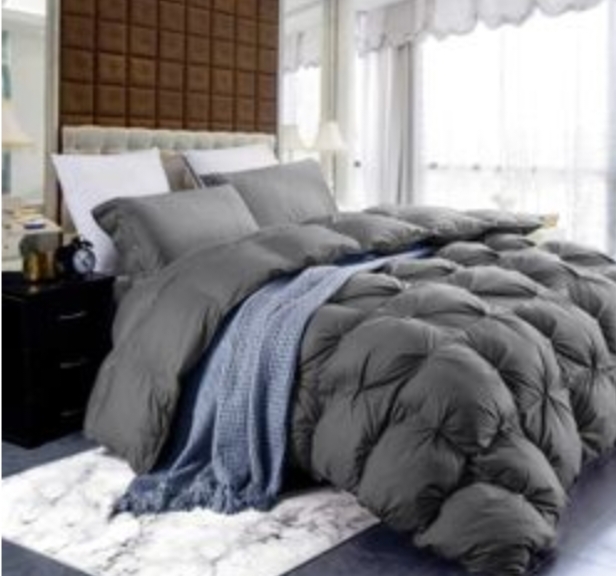A good night’s sleep is essential for overall well-being, and choosing the right bedding plays a significant role in achieving that.
Among various bedding options that are on offer, goose down comforters are highly sought after for their warmth, softness, and luxurious feel. However, not all goose down comforters are created equal. Selecting the one that perfectly matches your sleep needs requires a bit of thought and understanding of the different features that these comforters offer.
This article will guide you through the key factors to consider when selecting a goose down comforter that will enhance your sleep quality and comfort.
Understanding The Basics Of A Goose Down Comforter
When shopping for a goose down comforter, it’s important to first understand what sets it apart from other types of comforters.
Goose down, the soft layer of fine feathers found under the tougher exterior feathers of geese, is prized for its exceptional insulation properties. This material creates a comforter that is not only lightweight but also incredibly warm. A well-made goose down comforter can trap air efficiently, providing warmth without the bulk. These qualities make goose down comforters a favorite among those seeking luxury and comfort in their bedding. It’s also important to note that the warmth provided by a goose down comforter can vary depending on the fill power, which indicates the quality and loftiness of the down used.
By understanding these basics, you can better appreciate the features that matter most when choosing the perfect comforter.
Key Factors To Consider When Choosing A Goose Down Comforter
When deciding on the right goose down comforter, it’s crucial to consider several factors that can impact your overall sleep experience. Below are five important points to guide your selection.
1. Fill Power And Warmth Level
Fill power is a critical measure of a goose down comforter’s quality and warmth. It refers to the volume one ounce of down occupies, which in turn indicates its ability to trap air and provide insulation. Higher fill power numbers (600 and above) signify a fluffier, warmer comforter that offers better insulation without needing more down. This feature is particularly important for those living in colder climates or who prefer a warm and cozy sleep environment.
However, if you sleep hot or live in a warmer area, a comforter with a lower fill power might be more suitable.
2. Thread Count And Fabric Quality
The outer fabric of a goose down comforter plays a significant role in both its durability and comfort.
A higher thread count fabric, typically above 300, is usually softer and more durable, providing a luxurious feel while also being dense enough to prevent the down from leaking out. In addition to thread count, consider the type of fabric used; cotton is often favored for its breathability and softness.
Opting for a high-quality fabric ensures that your comforter will feel pleasant against your skin and last for many years.
3. Construction Type: Baffle Box vs. Sewn-Through
The construction of a goose down comforter influences how well the down stays in place and how evenly it distributes warmth. There are two primary construction types: baffle box and sewn-through.
Baffle box construction features fabric walls between the top and bottom layers of the comforter, creating individual chambers that prevent down from shifting and clumping. This design typically results in a more even warmth distribution.
On the other hand, sewn-through construction, where the top and bottom layers are stitched together, can be less expensive but may lead to cold spots due to down migration.
Choosing the right construction type is essential for maintaining consistent warmth and comfort throughout the night.
4. Size And Fit For Your Bed
Selecting the correct size for your bed is another important consideration. Goose down comforters come in standard sizes such as twin, full, queen, and king.
However, not all comforters are created equal in terms of dimensions, so it’s wise to check the measurements to ensure a good fit. A comforter that’s too small may leave parts of the bed uncovered, leading to an uncomfortable night’s sleep, while an overly large comforter might overwhelm the bed and feel too bulky.
Also, consider if you prefer a bit of overhang on the sides or if you want the comforter to fit more snugly within the bed’s edges.
5. Hypoallergenic Options And Maintenance
For those with allergies or sensitivities, hypoallergenic goose down comforters are available.
These comforters are often treated to remove impurities that can trigger allergies. It’s also worth considering how easy it is to maintain the comforter. Some goose down comforters require professional cleaning, while others are machine washable. Regular maintenance is key to prolonging the life of your comforter and keeping it fresh.
Therefore, it’s important to choose a comforter that aligns with your lifestyle and maintenance preferences.
Conclusion
Choosing the right goose down comforter involves considering a variety of factors that contribute to its comfort, warmth, and longevity.
By taking the time to evaluate these aspects, you can find a goose down comforter that not only enhances your sleep but also provides the perfect balance of warmth and luxury for years to come.
